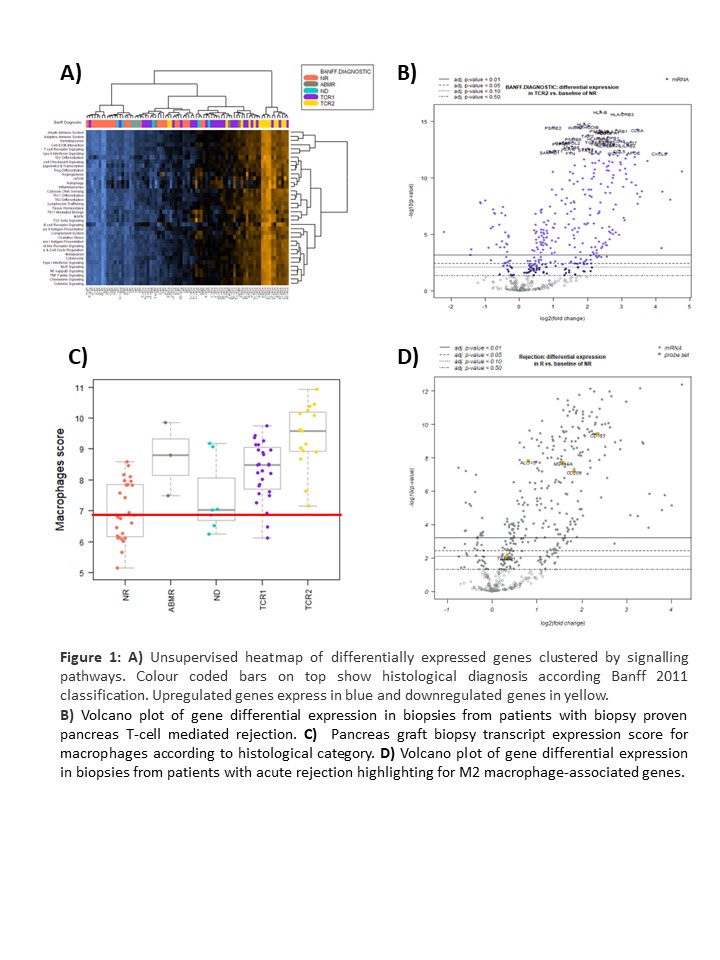Peripheral blood mononuclear cells transcriptomic profile reveals a more prominent role of innate immune cells in pancreas rejection
Maria Jose Ramirez-Bajo 1, Miriam Cuatrecasas3, M Angeles Garcia-Criado4, Laura Sanchez Salom1, Jordi Rovira1, Elisenda Bañón-Maneus 1, Pablo Uva8, Cinthia Drachenberg7, Candice Roufosse2, Joana Ferrer5, Fritz Diekmann1,6, Josep M Campistol1,6, Pedro Ventura-Aguiar1,6.
1Laboratori Experimental de Nefrologia i Trasplantament, Fundació Clinic - IDIBAPS, Barcelona, Spain; 2Department of Immunology and Inflammation, Imperial College London, London, United Kingdom; 3Department of Pathology, Center for Biomedical Diagnosis, Hospital Clinic Barcelona, Barcelona, Spain; 4Radiology Department, Center for Biomedic Imaging, Hospital Clínic Barcelona, Barcelona, Spain; 5Hepato-bilio-pancreatic Surgery Department, Hospital Clínic Barcelona, Barcelona, Spain; 6Nephrology and Kidney Transplant Department, Hospital Clínic Barcelona, Barcelona, Spain; 7Department of Pathology, University of Maryland School of Medicine, Bartimore, MD, United States; 8Pancreas Transplantation, Instituto de Trasplantes y Alta Complejidad (ITAC - Nephrology), Buenos Aires, Argentina
Background: T cells are key players in pancreas acute rejection and activated CD8+ T cells have been identified in peripheral blood from patients with pancreas graft rejection. But a correlation between the expression profiles of peripheral blood T cells and those infiltrating the graft during the acute rejection episodes has not been established.
Methods: We conducted a retrospective observational study aiming at comparing the profile from peripheral blood mononuclear cells (PBMCs) with those from the immune cells infiltrating the pancreas graft. To do so we characterized PBMCs by flow cytometry from 67 biopsy matched (biopsy-proven acute rejection [BPAR] n = 28; No rejection [NR] n = 39). RNA was extracted from 12 stored PBMC samples (NR n=3, TCMR n=6, ABMR n=3) and transcriptomic expression analyzed using the nCounter Human Immunology V2 Panel Gene from Nanostring©. Transcriptomic analysis from 80 paraffin-embedded pancreas biopsies was performed using the Human Organ Transplant panel (B-HOT) from NanoString© (NR n=27, Indeterminate [ND] n=7, TCMR n=43, ABMR n=3). The data were processed with nSolver software (v2.0; NanoString©).
Results: Phenotypic characterization of PBMC by flow cytometry showed a significant increase of T cells in BPAR compared to those without AR including CD8+ and CD4+, with a significant increase in CD8+ naïve and central memory, and CD4+ naïve. There were no major differences in the innate immune cells such as NK (CD3−CD56+), NKT (CD3+CD56+) or monocytes (CD14+). Transcriptomic analysis from PBMC revealed an increased differential expression of genes related to cell-ECM, antigen presentation, cell trafficking (ITGAM, B2M, and VCAM), granule exocytosis regulation (NKG7), and Th17 (IL23R, SMAD2) and innate (Casp-1, GNG11) chemokine and cytokine signaling (Table 1).
In the pancreas graft unsupervised expression profiling analysis revealed that overall molecular classification correlates in most cases with current Banff histological categories (figure 1A). Among the top 58 genes expressed in biopsies with histological TCMR (using non-rejection as reference), there was significant increase most canonical T cells genes (Figure 1B), including those expressed in activated cytotoxic CD8 T cells, CD4 regulatory T cells, and T follicular helper cells. Neutrophils, but not NK, related transcripts were increased in acute rejection including in ABMR. There was a significant increase in the differential expression of macrophage-related transcripts in both TCMR and ABMR (Figure 1C), particularly of M2 macrophages (Figure 1D).
Conclusion: Peripheral blood T cell phenotype, but not gene expression, resembled that identified in graft transcriptomic analysis. Innate immune cell trafficking and activation may have a more relevant role to the pathophysiology of pancreas graft rejection than that currently recognized.
